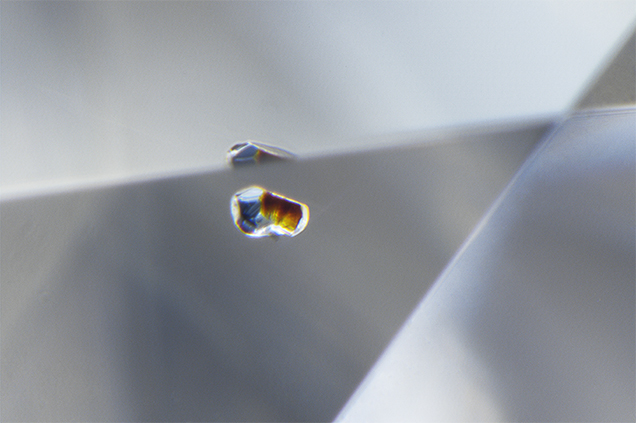Omphacite and Chromite: A "Bimineralic Inclusion" in Diamond

The micro-world of diamonds is fascinating not only to gemologists interested in inclusions but also to mineral physicists who study the deep earth, arguably one of the last frontiers and one not yet accessible to us. Diamond inclusions offer a window into that world and help us piece together its nature to unravel the mysteries of the earth’s very formation (J.I. Koivula and E.A. Skalwold, “The microworld of diamonds: Images from the earth’s mantle,” Rocks & Minerals, Vol. 89, No. 1, 2014, pp. 46–51). Sometimes even relatively common inclusions in diamond present an uncommon sight.
In this case, two minerals identified by Raman microspectroscopy, omphacite and chromite, are in such close association that they appear joined (see above). Such a “bimineralic inclusion” poses the question of how they might have ended up that way: Was it just fate or attraction? There is even the possibility that they were a single mineral at the time of inclusion into the diamond but separated when pressure and temperature dropped as the diamond found its way to the earth’s surface. Future detailed chemical analysis of this pair may yield valuable information about the earth’s interior, including the compositions, pressures, and temperatures of the host rocks in which the diamonds formed.
Many gemologists are familiar with so-called carbon spots in diamonds. Often these are actually chromite crystals—not carbon at all, but rather a chromium-rich iron oxide mineral of the spinel group. If thin enough, these may appear dark red-brown to yellowish brown in transmitted light, as seen in this specimen. Chromite is classified in both the peridotitic and eclogitic inclusion suites found in diamonds. By contrast, the omphacite crystal next to it is a monoclinic pyroxene mineral (clinopyroxene) that is typically pale to dark grayish green or grayish blue in transmitted light and considered a member of the eclogitic suite of inclusions found in diamonds. This inclusion specimen is not only worthy of the photomicrographer’s artistry but also a very valuable portion of the earth’s interior puzzle, which is slowly being put together one piece at a time.



